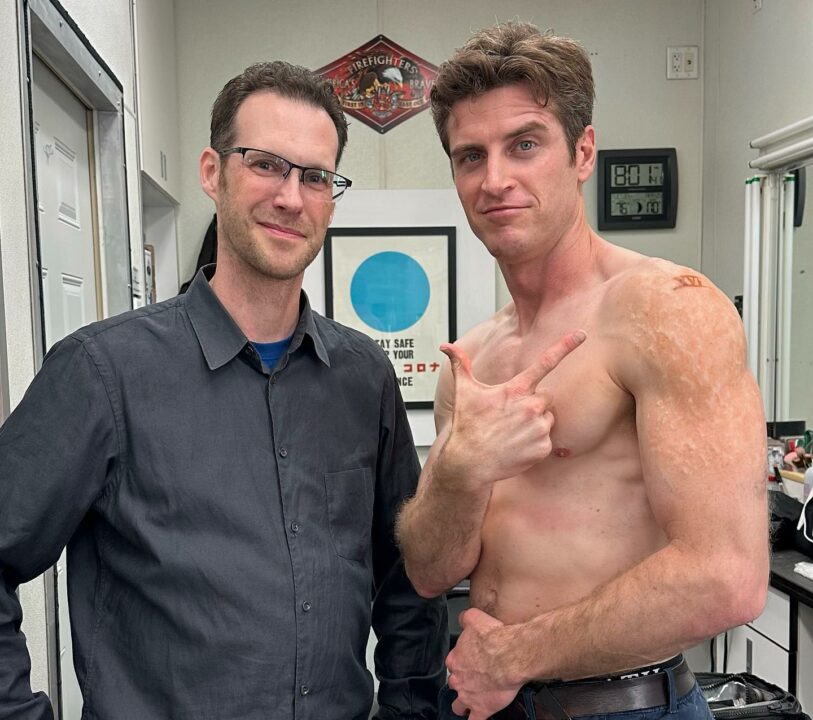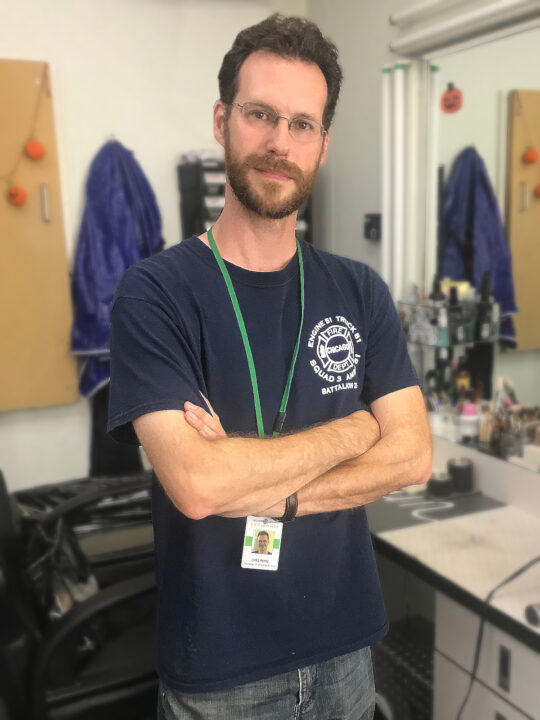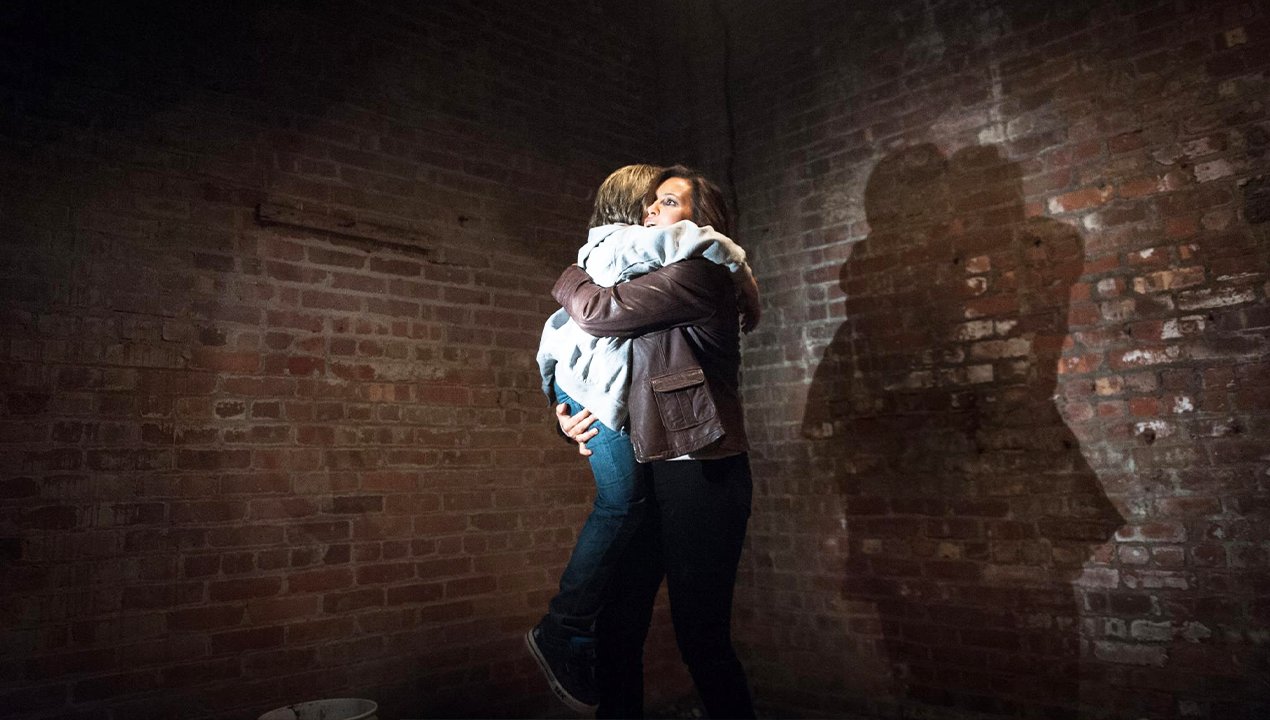Spotlight: Christopher Payne

There is certainly no shortage of serious burns on Chicago Fire — after all, the first responders of Firehouse 51 are responding to life-or-death emergencies. Of course, no one is actually sustaining injuries on set, and what you see on your screen is all thanks to the magic created by FX Makeup Department Head Christopher Payne. Since joining the Chicago Fire team during the show’s second season, Chris has been the mastermind behind the burns, cuts, and all other injuries you see on the show. We talked with Chris about how he found himself on this career path, how the FX team produces the thrilling and realistic effects you see on the show, and the impactful effects he’ll never forget creating.
How did you end up in your role as the FX Makeup Department Head on Chicago Fire?
Chris: When I moved back to Chicago from LA over a decade ago, I got a gig day-playing with Wolf in a bunch of different departments — set deck, props department, whoever needed an extra set of hands that day. One day I got a call from the Chicago Fire producers, who told me the person that they had had doing the special effects makeup was leaving and asked if I could come in and help out. I agreed, and showed up to that first production meeting portfolio in hand, thinking I would help out with a few episodes — turns out they wanted me to run the department.
What does a typical day on set look like for you?
Chris: We start very early in the day — more often than not I’m ready to go at 4am. Depending on what we’re working on that day, an actor’s makeup call takes anywhere from 30 minutes to 3 hours. I’ll sometimes have a second person helping me if it’s a big project, like full-body burn makeup. Once makeup is done, we head over to set, and for the rest of the day, my job is to maintain that makeup. It really takes a beating over the course of the day, especially if we’ve got makeup on someone who stands near actual flames or crawls around on the ground during the shoot. We just make sure that the quality stays where it needs to, so that we can get the footage we need.
View this post on Instagram
What kinds of effects do you use on the show?
Chris: Of course when you think of Chicago Fire, you think burns — we definitely create a lot of burns here, but there’s much more to the job than that. The practical effect that I do most often, outside of gluing things to people of course, are blood rigs. The way a blood rig typically works to simulate bleeding is by using what’s called a blood bladder: a flat balloon filled with fake blood, with tubes connected to it. That can be built into a dummy, or it can go on underneath a prosthetic on an actor. For example, if you imagine a character with a cut throat, that’s achieved using a prosthetic with a slit in it, sitting atop a blood bladder. The tubing will snake off, usually down the back of the actor’s shirt or down their leg, to make it invisible to the viewer. I will then set myself up just off camera — I’m so close I’m literally crouched down on the floor next to the actor — with pressurized containers full of blood that feed into those tubes. From that vantage point, I’m able to set and monitor the pressure on those, and once the director signals that they want the blood to start flowing, that’s when things get messy!
Do you have a particular favorite look or scene that you’ve worked on?
Chris: What I really love to do are things that are different from anything I’ve done before, even if they aren’t the most shocking. In Seasons 10 and 11, we had a character named Dell Cotner, a drug dealer who had a big full beard. While on a break, Mac Brandt, the actor who plays Dell, worked on another show where they made him shave off his beard, which I found out a week or two before he was due to come back to finish that storyline. When it came time to shoot again, I had to recreate his beard, gluing on hair by hand and working off of reference photos. I ended up having to do that twice. That was a lot of fun and definitely a technical challenge. It was so funny being on set and having people not realizing that it was a fake beard! I love opportunities like that, where I get to test my skills and my creativity.
View this post on Instagram
Do you ever work with the FX teams on other One Chicago shows?
Chris: A big part of my job is the ability to think on my feet, and if something comes up that I don’t know how to do, I do my research, test some things, and figure it out. I’ll also reach out to other makeup artists to get tips or advice. When we do a surgery scene, I’ll reach out to the team at Chicago Med and ask them if they’ve done that particular procedure, and if we have a problem, how did they solve it? They share their insight with me, and likewise, I help others when I can, like when other artists will reach out to me and ask what materials I like to use for certain burns. It’s so nice having that collaboration with the other One Chicago shows and being able to share our knowledge with each other.
View this post on Instagram
What role does editing play in creating these effects?
Chris: Occasionally, the practical effects that we create will get augmented in post. For instance, if we’ve done a blood pumping effect, and there’s a certain moment that the director wants an extra spurt of blood, they can add that in after filming. The practical effects in-camera provide a foundation for them to work with and expand on.
What’s your favorite episode of Chicago Fire?
I’ll always remember the first full episode I worked on: “When Things Got Rough” in Season 2. This one was based on a true story that consultant Steve Chikerotis had actually experienced during his career as a Chicago firefighter. In the episode, there’s a massive fire that threatens a family, and in a heroic moment, the father laid himself down on top of his family to protect them. They all made it, but he did not. I did the full body burn makeup on the father — it was both a very powerful scene and a serious project to kick off my tenure on the show.

Stream Chicago Fire on Peacock to see more of Chris’ masterful effects.
